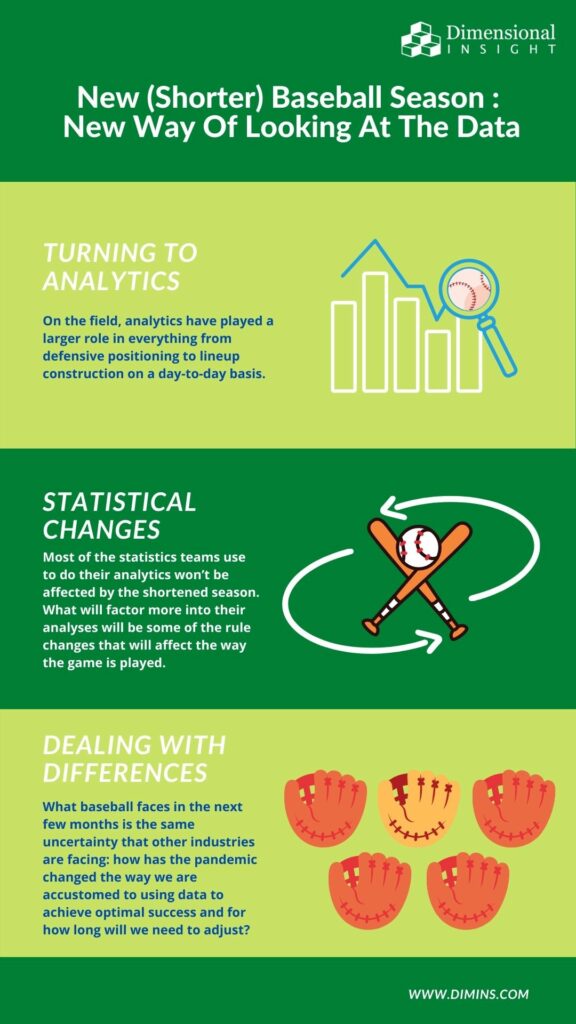It’s safe to say the 2020 Major League Baseball season will be unlike any other. Games will be played with no fans in attendance, and the fans watching from home will see a game that is at times completely different from what they’ve come to expect. Playing the game during a pandemic has resulted in rule changes as well as a shortened season and changes to the schedules teams play.
There are a number of effects the pandemic has had on baseball as an industry: no fans in the stands means there’s been a disruption to the ballpark vendor supply chain, and the sport will be dealing with financial repercussions for years. But as for the game on the field, it is one flush with statistics, and the analytics portion of baseball has to adjust for the 2020 season as well.
Turning to analytics
Like any other industry, the sports world has embraced data for everything from teams looking for any competitive advantage to players looking for personal improvement. In fact, some would argue sports has set the standard for other industries to follow in terms of seeing results from their data analytics work. In baseball, every organization uses data in a variety of ways. In the front office data is a factor in player analysis, whether that’s players within the organization or that the team is looking to add through the draft, trades, or free agency.
On the field, analytics have played a larger role in everything from defensive positioning (where players might be moved around on the field depending on the pitcher-batter matchups) to lineup construction on a day-to-day basis. Certain statistics have been emphasized more than others when determining player value. Most of those statistics are based on the traditional 162-game season. In 2020, teams will play just 37% of that number, for a total of 60 games.
Statistical changes
Most of the statistics teams use to do their analytics won’t be affected by the shortened season, or at least they are easily scalable from being averaged over 162 games down to 60. What will factor more into their analyses will be some of the rule changes that will affect the way the game is played. During the 2020 season all teams will use a designated hitter, where another position player takes the place of the pitcher in the lineup but doesn’t play the field. American League teams have used a DH for decades, but it is something new to consider for National League teams, and they will figure out how to maximize the value of that position.
Another rule change that has a significant impact on statistics is the fact that any extra innings will begin with a runner on second base in an effort to limit games from going too long. Statisticians will need to adjust the way they calculate certain statistics, like Wins Above Replacement (WAR), so that the pitcher starting the tenth inning, for instance, doesn’t see his performance penalized for a runner he did not put on base.

Dealing with differences
In some ways, teams will be dealing with less number-crunching this season. Due to the shortened season, and in an effort to limit travel and exposure to COVID-19, teams will only be playing the four other teams in their division and the five teams from the corresponding division in the other league. This will limit the need to analyze the data of every team in the majors, whether that’s opposing player performance or elements like the ballpark in which the game will be played.
The big question looming over baseball in 2020 is whether the pandemic will allow the season to be played to its completion, or whether another statistical anomaly will occur when the season is cut even shorter. What baseball faces in the next few months is the same uncertainty that other industries are facing: how has the pandemic changed the way we are accustomed to using data to achieve optimal success and for how long will we need to adjust?
Some of the changes baseball has put in place for 2020 are just to get the season in, like the 60-game schedule. But some changes, such as the universal designated hitter, are most likely here to stay. Like other industries have been forced to find out recently, it’s quite possible that being forced to look at the data in a different way will result in other changes moving forward that the organizations haven’t even realized yet.
- Summer is an Opportunity for Digital Transformation in Education - April 17, 2024
- Your Car is Tracking More than Miles per Hour - April 11, 2024
- Data Can Help Provide Equal Footing in Cannabis Space - April 3, 2024


